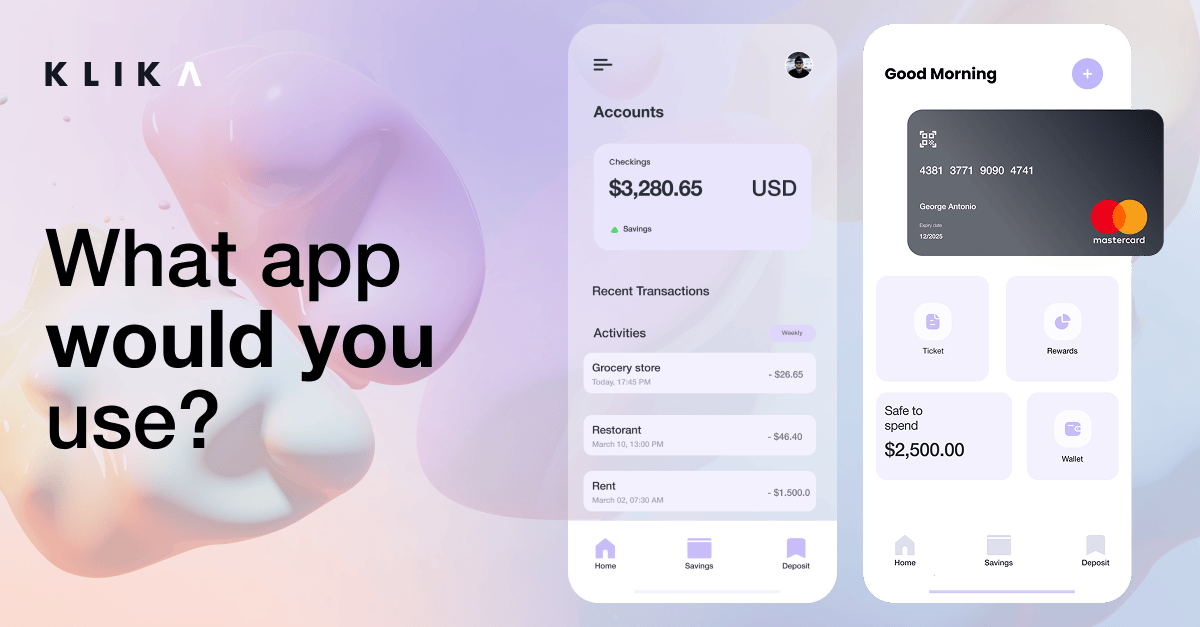May 22, 2025
Are Banks Losing the Wallet War?
Alisa Zejnilović, B2B Marketing Specialist
The fight for customer retention isn’t happening at the branch, it’s happening on the phone’s screen. And more often than not, it’s not your app being tapped.
Across Europe, 46% of Gen Z now use third-party finance apps daily: wallets, savings tools, crypto accounts, reward platforms; often in place of their bank’s native app. This isn’t a niche behavior. It’s a shift in financial behavior and power. And it is no longer a two-horse race - the competition isn’t another bank, it’s Apple Wallet, Revolut, and any app that earns a place in a user’s daily routine.

The Problem: Banks Are Losing the Primary Interface
Traditional banks are watching a critical shift unfold: the decoupling of financial services from their platforms. While core banking functionality remains intact behind the scenes, the front-end relationship is migrating elsewhere - to digital wallets, neobanks, and ecosystem-first apps.
Even banks with strong mobile apps are facing attrition in usage frequency. Why? Because customers, especially younger demographics, are using third-party apps that better align with how they live, shop, save, and transact.
If your bank’s app isn’t the first point of contact, it won’t be the first choice when new financial needs arise.
The Cause: Wallets and Neobanks Have Reframed User Expectations
Digital wallets and neobanks are not the same, but they are both redefining the customer interface.
Digital wallets (like Apple Pay, Lydia, Stocard, Curve) are becoming hubs for spending, saving, and identity - not just payment pipes.
Neobanks (like N26, Revolut) are delivering full-stack experiences with superior UX, instant onboarding, modular products, and lifestyle integration.
More and more customers are migrating to these apps because, the bottom line, they do two things well:
Remove friction
Add daily value
They don’t replicate traditional banks; they leapfrog them in interface design and user relevance.
The Strategic Consequence: You’re No Longer Just a Bank
Once digital wallets offer:
Payment
Loyalty cards
Subscription management
P2P and split payments
Credit and savings tools
…they stop being accessories and become the new default interface. The bank becomes the backend. The infrastructure. Invisible.
And with the Digital Euro on the horizon, wallets are gaining systemic importance - not just convenience.
The European Central Bank (ECB) is actively developing the Digital Euro, a central bank digital currency (CBDC) designed to provide citizens with a secure, universally accepted form of digital cash. Slated to move into the preparation phase by 2025, it will be distributed via digital wallets, not directly through traditional banks.
This shift will erode the exclusivity banks have historically had over holding and distributing public money. For consumers, it means the same wallet that holds currency, ID, mobility passes, loyalty cards, and access tokens can also be the home of state-backed digital cash.
Why would users navigate five siloed apps when a single wallet becomes their universal financial and identity interface?
For banks, this marks a turning point: if you’re not the interface, you’re infrastructure. And infrastructure gets commoditized.
China’s case study: a wake-up call for European banking
We’re already seeing this dynamic play out in China; their financial transformation offers a compelling case study for Europe. Platforms like Alipay have evolved from e-commerce payment tools into full-fledged financial ecosystems - offering savings (Yu’e Bao), insurance (Zhong An), personal credit (Ant Micro Loan), and even consumer credit scoring (Sesame Credit). What makes this shift significant is disintermediation: Alipay reduces reliance on traditional banks by handling transactions, credit, and even settlements internally, cutting out legacy intermediaries like China UnionPay entirely.
As Chinese users increasingly choose digital wallets over bank apps, state-owned banks have been forced to innovate or risk irrelevance. And now, with the rollout of the e-CNY, users can access central bank money directly through wallets like Alipay and WeChat Pay, without logging into a traditional banking interface.
The message for Europe is clear: if the Digital Euro follows a similar path, the wallet - not the bank - becomes the dominant layer of financial interaction. For banks, this means two choices: compete as a daily interface or be relegated to invisible infrastructure.
What Now? Strategy Before Speed
…they stop being accessories and become the new default interface. The bank becomes the backend. The infrastructure. Invisible.
And with the Digital Euro on the horizon, wallets are gaining systemic importance - not just convenience.
The European Central Bank (ECB) is actively developing the Digital Euro, a central bank digital currency (CBDC) designed to provide citizens with a secure, universally accepted form of digital cash. Slated to move into the preparation phase by 2025, it will be distributed via digital wallets, not directly through traditional banks.
This shift will erode the exclusivity banks have historically had over holding and distributing public money. For consumers, it means the same wallet that holds currency, ID, mobility passes, loyalty cards, and access tokens can also be the home of state-backed digital cash.
Why would users navigate five siloed apps when a single wallet becomes their universal financial and identity interface?
For banks, this marks a turning point: if you’re not the interface, you’re infrastructure. And infrastructure gets commoditized.
Banks have two clear paths:
Try to protect their existing app experience (and risk falling behind), or
Redesign the customer experience around daily relevance, not just regulatory compliance.
That doesn’t mean launching a copycat wallet. It means rethinking the user journey from login to loyalty.
Here’s what winning banks are already doing:
Embedding budgeting, rewards, lifestyle nudges, and micro-investment tools into the app, not as features, but habit-forming daily touchpoints.
Using AI to hyper-personalize nudges and product offers in real-time, based on behavior, not just age or income brackets.
Offering instant, transparent onboarding with personalization from day one.
Partnering with fintechs, telecoms, and retail ecosystems to stay embedded in user lifestyles
B2B2X Models: Embedded Finance with Real Impact
Banks are increasingly moving beyond traditional B2B to B2B2X - where “X” is the end customer.
Instead of waiting for consumers to walk into a branch, they’re embedding banking products directly into partner ecosystems - from car dealerships offering instant financing to real estate platforms streamlining mortgage approvals at the point of search.
Example: A bank partners with a car manufacturer to offer embedded leasing and financing within the digital showroom. The consumer never leaves the ecosystem, but your bank powers the transaction.
This model allows banks to:
Expand distribution without new branches
Capture high-intent customers at the moment of need
Retain relevance in a landscape shaped by platforms, not pipelines
Proven digital strategies top banks are using
We’ve distilled the most effective loyalty strategies, from AI to UX, in one executive guide. See how banks are staying relevant across digital touchpoints.
Get the playbook here!
The Solution: Compete on Interface, Not Just Infrastructure
Digital wallets aren’t just adding convenience, they’re training your customers to expect more.
To compete, banks must:
Shift from compliance-led releases to product-driven roadmaps
Deliver modular, composable services without overhauling core systems
Treat AI and personalization not as “features,” but as retention engines
Launch smaller, faster MVPs - then iterate with user data (not just stakeholder input)
This isn’t digital transformation. It’s interface strategy.

Final Word: Reclaim the Frontline
Banks that win the next decade will be those who own the interface, not just the ledger.
Your customer will still need a bank. But whether they interact with you, or through someone else will depend on what you do now.
The wallets are open. The question is: whose app do they open first?
If you’re mapping your next move in the wallet race, Klika can help.
We bring in cross-functional delivery squads, from UX to DevOps, to help banks build MVPs in weeks and evolve with real user feedback.
The Klika model: fast, modular, personalized:
Add new wallet features without replacing core systems
Layer in AI, automation, and behavioral UX where it matters
Scale with cloud-native, composable architecture
Industries
Expertise
Android
iOS
Java
Javascript
.Net
Ruby
Python
C/C++
Flutter
Angular
Blockchain
© 2025 Klika d.o.o.